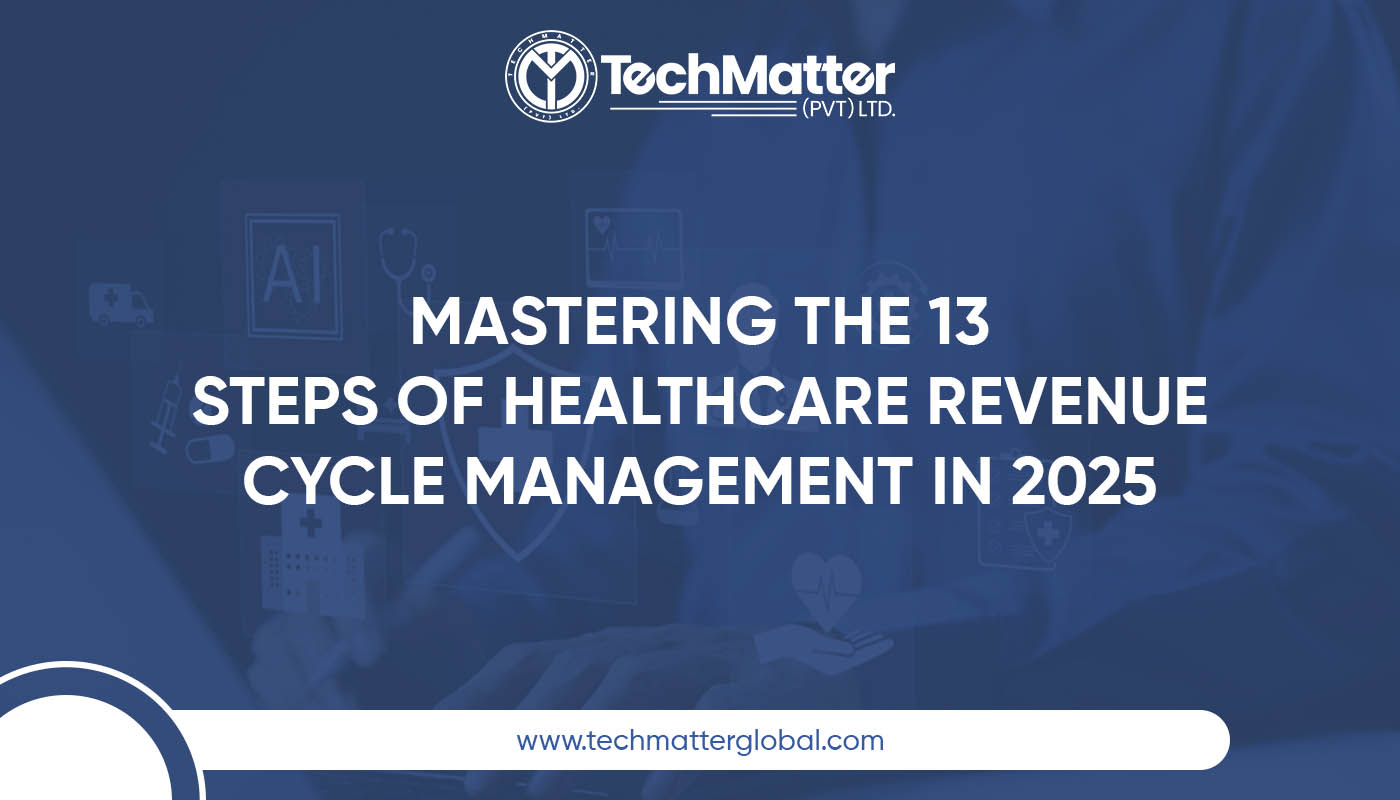In the ever-evolving healthcare landscape, mastering revenue cycle management services has never been more crucial. In order to preserve financial stability and improve patient care as 2025 progresses, healthcare providers are putting emphasis on optimizing their revenue operations. From insurance verification to compliance management, every step plays a vital role. Let’s delve into the 13 essential steps to efficiently manage the healthcare revenue cycle in 2025.
Healthcare Revenue Cycle Management
Healthcare revenue cycle management (RCM) services include the entirety of financial management related to the patient care process. This includes managing patient revenue beginning at the initial appointment through to when the last payment is made, allowing a healthcare organization to receive proper payment for service when due.
Importance of the RCM sector in 2025
The healthcare organization in 2025 is one that is straddled, or perhaps bursting, with challenges that did not exist even a few years prior – more and more regulations and requirements around patient-centric care are just two we would note here. RCM services that offer efficiencies for healthcare organizations help alleviate these challenges through reduced claim denials, increased compliance, and ultimately revenue-enhancing performance.
Why RCM Is Crucial for Healthcare Providers
- Accurate and efficient revenue cycle management services help healthcare providers deliver quality care without financial interruptions. Effective RCM can achieve a seamless cash flow and reduce unpaid claims and lost revenue.
- With new healthcare regulations popping up every year, compliance is also a key role of revenue cycle management. RCM services will keep billing practices within the stream of new laws which can help mitigate fines or penalties on health care providers.
- Having streamlined revenue cycle management services will also improve the patient experience. Billing with transparency and insurance processing will allow patients to enjoy the experience without feeling as though there are hidden costs.
The 13 Essential Steps of Healthcare Revenue Cycle Management
Step 1: Patient Registration
Following accuracy in patient registration process in a key for effective revenue cycle management services. Which involves the collection of critical information including the area of living as well as the insurance location.
Step 2: Insurance Verification and Eligibility Check
Insurance verification in real-time is a crucial step to validate the coverage for all the services and amount of the patients’ responsibility. By identifying coverage problems/issues early on, the provider can avoid the impact of claim denials and move the process to bill and get paid more quickly.
Step 3: Pre-authorizations and Referral Management
Some treatments and procedures must be pre-authorized. Careful management of pre-authorizations is extremely important to avoid claims denials. Revenue cycle management services will have automated systems to track referrals or authorizations when required.
Step 4: Patient Financial Counseling
Making healthcare costs more transparent builds the patients trust. Providing financial counseling when patients are being registered is a good measure to ensure patients understand their financial responsibility. The more clearly an organization communicates these costs, the less chance of payment delays and overall patient satisfaction improves.
Step 5: Medical Coding and Documentation
The importance of accurate medical coding cannot be overstated. In 2025, coding has only become more complicated with the expectations that staff members are expert coders in the area of ICD-10 and CPT codes. The primary value of precise documentation is to minimize the risk associated with errors, but also, precise documentation supports revenue cycle management services.
Step 6: Claims Submission
The main goal is to submit claims accurately the first time. Getting claims submitted promptly and keeping the process simple are key. Using electronic claims submission is more efficient and lessens the potential for manual transcription errors and speeds up the reimbursement timeline. Using detailed claim forms as updates to existing claim forms based upon specific payer preferences can also serve to reduce claims rejections or denials.
Step 7: Denial Management and Appeals
Claim denials should be handled as soon as possible because this is a significant area of revenue cycle management services. Knowing the deleted reasons(rationales) for the claim denials – even if they are only due to coding and/or service documentation flaws – allows health care providers to apply and timely appeals.
Step 8: Payment Posting and Reconciliation
Once payments are received, payment posting quickly and accurately is critical. Automated reconciliation workflows will allow tracking of payments received and reconciled, negative payment postings, and manage timely updates to the patient accounts.
Step 9: Patient Billing and Statements
Clear and less-complex billing statements encourage those patients to pay within the standard success period. Varied digital payment options makes payment availability easier and timely invoice reminders help provide to patients the necessary follow-up and reduce missed payments.
Step 10: Collections and Accounts Receivable Management
Managing outstanding balances efficiently is essential for maintaining cash flow. Implementing patient-friendly collections practices, such as flexible payment plans, helps reduce outstanding debt.
Step 11: Reporting and Analytics
Data-driven insights are essential for optimizing revenue cycle management services. Monitoring key performance indicators (KPIs) like claim acceptance rates and days in accounts receivable (AR) helps identify improvement areas.
Step 12: Compliance and Audit Management
Staying compliant with evolving healthcare regulations is non-negotiable. Conducting regular internal audits ensures that billing and documentation practices align with industry standards.
Step 13: Continuous Process Improvement
Healthcare providers must be often evaluating their revenue cycle management services to discover inefficiencies, and utilize RCM software solutions that automate a provider’s daily tasks, reduce errors and optimize collections.
Conclusion
The healthcare revenue cycle management (RCM) services in 2025 will continuously emphasize efficient processes, accurate submissions, and a patient-centered focus. Providers should have a firm grasp of these 13 steps to maintain financial viability, decrease denials, and improve patient satisfaction. It is important that providers remain agile, as the technology and regulations will continue to evolve. A commitment to continuous improvement will continue to be the foundation of successful RCM.

Leave a Reply